Kotlin / Ktorでサンプルプログラムを書いていて、Google OAuth認証を実装したのだが、だいたい実装完了したタイミングで、 公式ページ を発見してしまい、このコードはお蔵入りになることが決定した(涙)。
サーバサイド含めて1日ぐらい格闘していたので、ただ捨てるのも忍びなくここに記載しておく。
シーケンス図
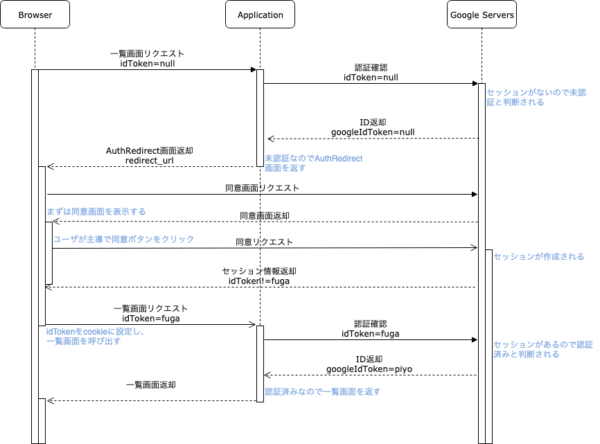
上記のシーケンス図の通り実装したが、全部書くのも大変なので、以下の2点だけ記載しようと思う。
- ApplicationからGoogle Serversに対して認証済みかどうかを確認する処理
- AuthRedirect画面の実装
Google APIsでOAuth 認証用のプロジェクトを作成
- プロジェクトを作成する
-
https://console.developers.google.com にてプロジェクトを作成する。今回は
Kotlin Ktor Sampleという名前で作成する。
-
https://console.developers.google.com にてプロジェクトを作成する。今回は
- OAuth 同意画面の設定を行う
- アプリケーション名とメールアドレスを設定して、保存ボタンを押せば良い。
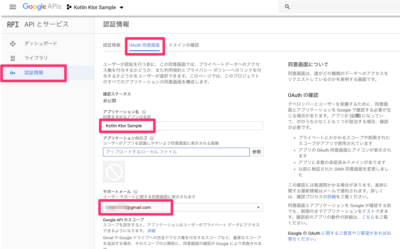
- アプリケーション名とメールアドレスを設定して、保存ボタンを押せば良い。
- 認証情報の作成を行う
- OAuth クライアントIDを選択する
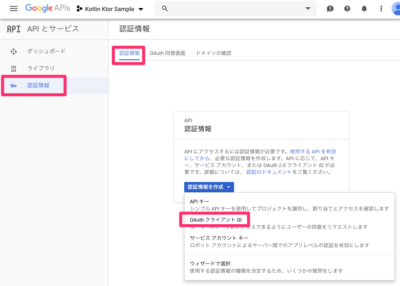
- OAuth クライアントIDを選択する
- OAuth クライアントIDの作成を行う
- ウェブアプリケーションを選択、「名前」「承認済みの JavaScript 生成元」を設定し、作成ボタンを押す
- 今回は、Webサーバでリダイレクト処理を行わないため「承認済みのリダイレクト URI」は設定しなくて良い
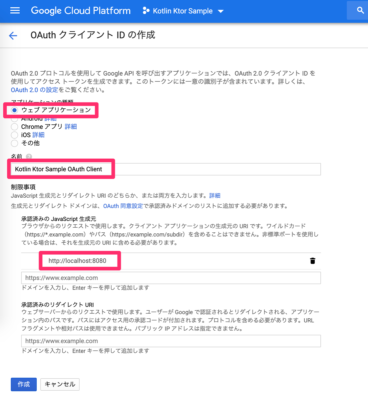
- クライアントIDとクライアントシークレットが作成される
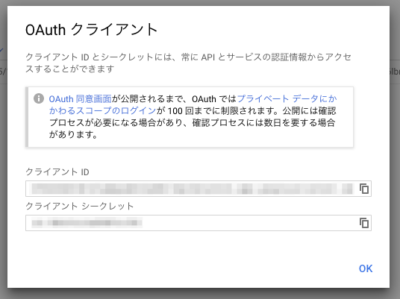
- ライブラリは特に何も有効化してない
ApplicationからGoogle Serversに対して認証済みかどうかを確認する処理
Authentication.kt に認証処理を実装する
ポイントは、未認証だったらAuthenticationExceptionをthrowしているところ。
package sample
fun Application.authenticate(idTokenString: String) {
val clientId = environment.config.property("app.google.client_id").getString() // ここでconfigから値を取得したいので、Applicationに関数を生やしている
authenticateByGoogle(idTokenString, clientId)
// こんな感じでアカウントの情報を取得できる
// val idToken: GoogleIdToken = authenticateByGoogle(idTokenString, clientId)
// val payload: GoogleIdToken.Payload = idToken.payload
// val subject: String = payload.subject
// val email: String = payload.email
}
private fun authenticateByGoogle(idTokenString: String, clientId: String): GoogleIdToken {
val transport = NetHttpTransport()
val jsonFactory = JacksonFactory.getDefaultInstance()
val verifier: GoogleIdTokenVerifier = GoogleIdTokenVerifier
.Builder(transport, jsonFactory)
.setAudience(Collections.singletonList(clientId))
.build()
// 確認結果がnullの場合はAuthenticationExceptionをthrowしている
return verifier.verify(idTokenString) ?: throw AuthenticationException()
}AuthenticationException をcatchしたらAuthRedirect画面にredirectする処理を statusPages に追加する
:
// StatusPagesを設定
install(StatusPages) {
data class ErrorResponse(val message: String?)
:
exception<AuthenticationException> {
call.respondRedirect("http://localhost:8080/static/authRedirect.html")
call.respond(HttpStatusCode.Unauthorized)
}
exception<Throwable> {
it.printStackTrace()
call.respond(HttpStatusCode.InternalServerError, ErrorResponse(it.message))
}
}
:AuthRedirect画面(authRedirect.html)の実装
Google Sign-In JavaScript client reference を参照しながら実装した。
<!DOCTYPE html>
<html lang="en">
<head>
<meta charset="UTF-8">
<title>Google OAuth Redirect | Sample</title>
</head>
<body>
<script src="https://apis.google.com/js/platform.js?onload=init" async defer></script>
<script>
function init() {
var redirectUrl = "http://localhost:8080/contents/"; // 実際はFreeMarker経由でリダイレクト先のURLを受け取り設定する
gapi.load('auth2', function() {
var config = {
client_id: 'xxxxx.apps.googleusercontent.com', // 実際はFreeMarker経由で環境変数から値を取得する
scope: 'profile email',
response_type: 'id_token'
};
// OAuth同意画面をポップアップ表示して認証を行う
gapi.auth2.authorize(config, function(response) {
if (response.error) {
alert('Error Occurred!!'); // 実際はエラーの種類は判別できるのでメッセージを変える方がよさそう
return;
}
// idTokenをcookieに設定する
var idToken = response.id_token;
document.cookie = "idToken=" + idToken + "; path=/; max-age=86400"; // とりあえず1日
// 元々表示しようとしていた画面にリダイレクトする
window.location.href = redirectUrl;
});
});
}
</script>
</body>
</html>